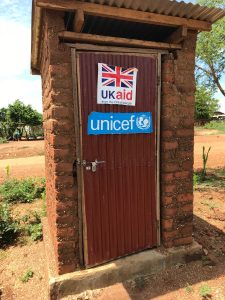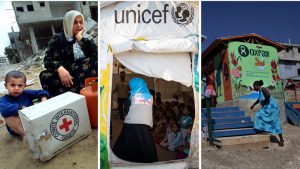Logos on aid supplies: Helpful or demeaning?
When a humanitarian group hands out bags of food or sets up toilets for people who are poor or recovering from a crisis, the group puts its logo on the product. It’s a way of taking credit, which makes donors happy. It’s a way of letting the recipients know where to complain if there’s a problem. And if you’re sitting at home and catch the logo on a TV report, you might be inspired to contribute to that particular charity.
But now, some people are questioning the branding of aid goods. The first concern: How do the logos make aid recipients feel?
 Ian Birrell, an international reporter and a contributing editor to Great Britain’s The Mail on Sunday, tweeted an image of a corrugated latrine door from a trip to the Bidi Bidi refugee camp in Uganda in May. Birrell wrote, “So demeaning for those who fled chaos and carnage to be endlessly reminded of their supplicant status.”
Ian Birrell, an international reporter and a contributing editor to Great Britain’s The Mail on Sunday, tweeted an image of a corrugated latrine door from a trip to the Bidi Bidi refugee camp in Uganda in May. Birrell wrote, “So demeaning for those who fled chaos and carnage to be endlessly reminded of their supplicant status.”
Sudhanshu S. Singh, CEO of an India-based emergency relief group called Humanitarian Aid International, agrees.Singh recalls a time when a major relief group provided plastic water buckets for aid recipients — with its logo emblazoned on each pail in huge letters. “I think it’s unfair as each time people take out the bucket to fetch water, others would immediately notice that it is part of the dole,” he says.
Many recipients don’t mind the logos. Cedric Habiyaremye, a Rwandan Ph.D. student at Washington State University, remembers when he was living in a refugee camp in Tanzania as an 8-year-old. Each day, he would see trucks labeled “WFP” — short for World Food Programme, the U.N. food agency — come into the camp.” We were full of joy, because we knew we were going to eat at that time,” he says. “It was a very reassuring time of day. … I feel that I am glad I got to know who served me at the refugee camp.”
Habiyaremye got a chance to visit World Food Programme in Washington, D.C., after he won a global agriculture award. He was so excited to meet some of the staff. “I’d been waiting for this moment for my entire life,” he says he told them. “I just wanted to tell them thank you.”
[NPR] Read more

 Such logos also help ensure that charities and donors get credit for their good deeds. According to USAID’s branding guide, their red, white and blue logo “was developed to ensure that the American people are visibly acknowledged for their contributions.”
Such logos also help ensure that charities and donors get credit for their good deeds. According to USAID’s branding guide, their red, white and blue logo “was developed to ensure that the American people are visibly acknowledged for their contributions.”